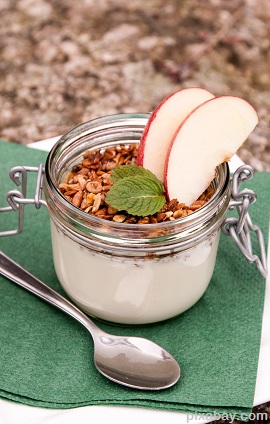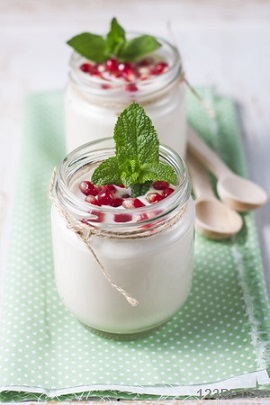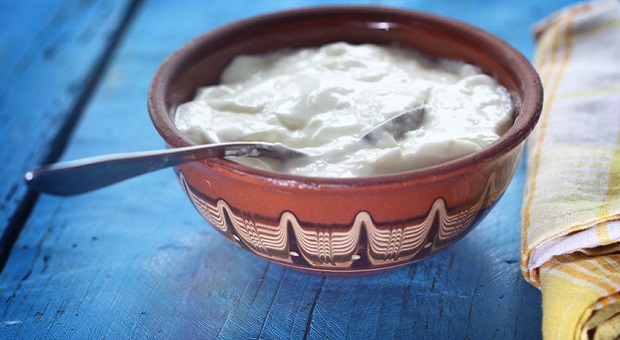Yogurt is a delicious, healthy snack, lunch or ingredient that, though typically made from cow’s milk, can be made from many different types of “milks” including almond milk and coconut milk. These require some extra ingredients but still offer many health benefits. Today we’re going to tell you how to make yogurt at home regardless of the milk that you want to use.
The recipes and methods that we’re going to review don’t require a yogurt maker because in a survival situation you may not be able to use it. Also, it’s an unnecessary piece of equipment as long as you’re willing to put in a bit of extra effort.
As with all things made at home, homemade yogurt is superior to store-bought yogurt because you know what’s in it, it’s cheaper, it’s better for the environment and the biggie – if SHTF, there’s not going to be a grocery store to buy it from so you’ll need to know how to make it yourself if you want it!
Traditional Yogurt
You’re going to find about a million different recipes to make yogurt online but many of them aren’t suited to the beginner yogurt maker. Some will turn out too tangy, some will turn out runny and some won’t turn out at all. We’re trying to make this as simple as possible so that your yogurt will turn out every time.
{adinserter emp}Yogurt, regardless of what type of “milk” you use, is packed with probiotics that help with everything from digestive health to promoting healthy skin and hair. You can even use yogurt in a face mask as part of your beauty routine as a softener. If you’re using dairy milk, it also works as a mild exfoliant.
I’m going to use a cheat here – a bit of store-bought plain yogurt as the “starter” because it’s much simpler. The only other way to start it is using chili stems to create the bacteria in the milk. If you want to try this, place several chili pepper stems in the milk after you’ve brought it to 160 degrees F and keep the milk warm until the concoction thickens. Alternatively, there are freeze-dried yogurt cultures that you can order online.
I also use whole milk though I’ve heard it works with 2% or skim milk, too. Here’s what you’ll need to make a half-gallon of yogurt. By the way, the amount of yogurt you end up with is the same as the amount of milk that you start with.
We’re making a half-gallon here because it’s enough to make different flavors but isn’t so much that it will spoil before you can use it. Feel free to double or halve the recipe.
 Ingredients:
Ingredients:
- ½ gallon of milk (cow or goat)
- ¼ cup plain yogurt with live cultures
- 2 quart jars or 4 pint jars, rings, and tops, sterilized
- 1 gallon stock pot with a heavy bottom
- 1 cooking or candy thermometer
- Heating pad or warm spot such as an oven with a pilot light
Instructions:
- Heat your milk in the pot until it reaches 180 degrees F according to your thermometer. Remove from heat.
- Let the milk cool until it’s 115 degrees F and stir in the yogurt. Stir well to combine.
- Pour the mixture into the jars and put the lids on.
- Place in the warm spot such as your oven with the light on or wrap in the heating pad on low setting.
- Leave it alone for 10-12 hours. The longer it sits, the tangier it will be.
- Chill the yogurt well, for at least 3-4 hours. Don’t worry if it’s still thin because it will thicken as it cools.
- That’s it. You’ve just made yogurt. Now that you’ve made it, set aside ¼ cup for your next batch!
Note:
1. If you’re using freeze-dried starter, the fermentation process will only take 4 hours or so. Also, make sure that the milk that you use is of high quality. Organic, non-pasteurized milk is my preference. Go organic, at least.
2. This yogurt is going to be a bit thinner than store bought. If you want to thicken it a bit, add ¼ cup dried milk per half gallon – stir it in when you add the yogurt culture.
3. You can freeze your yogurt in 1 cup containers.
4. You may have extra water (aka whey) in the yogurt. If so, line a sieve with cheesecloth or a linen towel and pour your yogurt in so that the whey can drain before you put the yogurt in your jars.
Alternate crock pot method: Bring the milk to 180 degrees in your crock pot on high, then follow the directions above. To cool it, remove the crock from your pot and wrap it in a towel, place it in the oven (with the oven off) and let it sit. I like to heat the oven for a few minutes first, then turn it off before I put the yogurt in so that it’s nice and warm in there.
Almond Milk Yogurt
 You can’t make almond milk yogurt from boxed almond milk – you have to make the milk yourself. You can do this with fresh almonds and a juicer or blender. This makes about 2 quarts of almond yogurt. Don’t skip the sugar – it’s the culture food!
You can’t make almond milk yogurt from boxed almond milk – you have to make the milk yourself. You can do this with fresh almonds and a juicer or blender. This makes about 2 quarts of almond yogurt. Don’t skip the sugar – it’s the culture food!
Ingredients:
- 2 cups raw almonds
- 1 tsp. agar agar powder
- 2 tablespoons sugar
- ¼ arrowroot powder
- Water
- Freeze-dried yogurt starter
Instructions:
- Soak the almonds in water for 8-10 hours.
- Put the almonds through the juicer or use a high-powered blender, adding enough water to make 4 cups. Blend until it’s smooth then strain the chunks out.
- Add back to the blender and add enough water to bring it back up to the 4-cup mark.
- Mix arrowroot with ½ cup of water.
- Put 3 cups of water into a 2-quart pot and add the agar agar. Bring it slowly to a boil. Be careful because it will boil over.
- Simmer for 15 seconds and remove from heat.
- Add the milk and the arrowroot mixture and whisk well. Allow to cool to 105 degrees.
- Add the yogurt starter according to package directions to ¼ cup of the cooled almond milk and whisk well to combine.
- Pour into jars and place in warm spot such as the preheated and turned off oven and allow to ferment for 10 hours.
- Chill for 3-4 hours and the yogurt will set as it chills.
Coconut Milk Yogurt
 This one is a piece of cake. Combine 1 can of full-fat coconut milk (not the sweetened kind) at room temperature and 1 tablespoon of Inner Eco coconut water probiotic kefir or probiotic capsule. Combine the milk and the probiotic well and pour into a jar. Put it in the oven with the light on or wrap it in a heating pad for 10 hours or so.
This one is a piece of cake. Combine 1 can of full-fat coconut milk (not the sweetened kind) at room temperature and 1 tablespoon of Inner Eco coconut water probiotic kefir or probiotic capsule. Combine the milk and the probiotic well and pour into a jar. Put it in the oven with the light on or wrap it in a heating pad for 10 hours or so.
Note: If you want it thicker, put the coconut milk in the fridge so that the cream rises to the top. Pour the cream out and leave the water in the bottom.
Now you know how to make a few different types of plain yogurt! If you want to flavor them with fruit or other flavorings, do so either when you serve it or before you put it in the jars.
Do you have any other suggestions for making yogurt? If so, tell us about them in the comments section below!
This article has been written by Theresa Crouse for Survivopedia.




















































































For ours I use 1 quart coconut milk heated to 98 degrees. Stir 1 teaspoon probiotic powder set in warm place for 6 to 10 hours depending on how thick you want it. I forget where I got this recipe. Most likely from backyard survival.
Curious to know what the difference is between Yogurt and Kefir? And how do they differ in ingredients and making techniques if I would try to make them at home? Thanks for any help.
The almond milk recipe calls for 1/4 arrowroot powder. is that tsp, cup, etc????? Thx. Great ideas.
The standard is to use 1.5-2 tbsp arrowroot powder per 4 cups of milk. Sorry about that!
Oh, and you can mix it with the almond milk instead of water for a richer, thicker yogurt. 🙂
After doing without yogurt for way too long, I recently started making it again, craving Greek yogurt. I’m doing mine at higher temps, per advice of a great website I found (), where he recommends incubation at 122 degrees F (the culture bacteria die at 130); the yogurt progresses very well at this temp for me. I also use his suggestion to incubate in an ice chest, resting the heating pan or the jars in warm water for the fermentation period. It works great. I’m straining it to turn it into very thick Greek-style yogurt, & am replacing the sour cream we have been using. It’s sooo delicious!
I’d like to see a complete recipe for Greek yogurt. Or know how to adapt the recipe posted. Thanks.
Yes I agree with another person who posted interest in a recipe for greek yogurt. Would you share the recipe you have?
I enjoy making yogurt the easy way using a crock pot. Pour 1/2 gallon milk in and turn on to low for 2 1/2 hours. Unplug for 3 hours. Add yogurt, and dry milk if you wish, stir and wrap in a heavy towel for 8 hours.